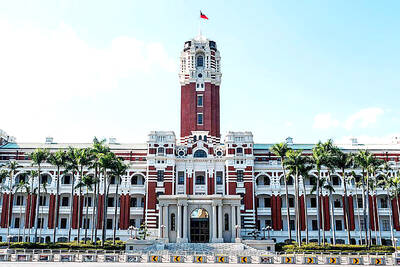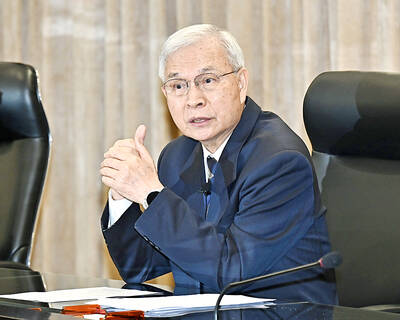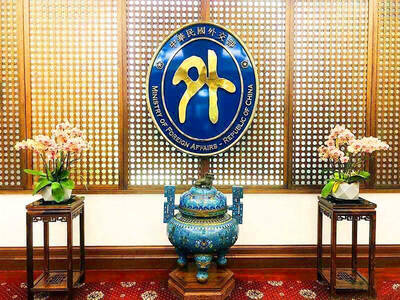The US is “opening fire” on the world with its threatened tariffs, China said yesterday, adding that it would respond the instant US measures go into effect as Beijing ramped up the rhetoric in a bitter trade dispute.
The US tariffs on US$34 billion of Chinese imports are scheduled to go into effect just after midday today.
US President Donald Trump has threatened to escalate the trade conflict with tariffs on as much as US$450 billion of Chinese goods if Beijing retaliates, with the row roiling financial markets and the global trade of commodities from soybeans to coal.

Photo: AFP
China has said it would not “fire the first shot,” but the Chinese General Administration of Customs yesterday made it clear that Chinese tariffs on US goods would take effect immediately after US duties on Chinese goods kick in.
Speaking at a weekly news conference, Chinese Ministry of Commerce spokesman Gao Feng (高峰) said that the proposed US tariffs would hit international supply chains, including foreign companies in the world’s second-largest economy.
“If the US implements tariffs, they will actually be adding tariffs on companies from all countries, including Chinese and US companies,” Gao said.
“US measures are essentially attacking global supply and value chains. To put it simply, the US is opening fire on the entire world, including itself,” he said.
“China will not bow down in the face of threats and blackmail, and will not falter from its determination to defend free trade and the multilateral system,” he added.
Asked whether US companies would be targeted with “qualitative measures” in China in a trade war, Gao said the government would protect the legal rights of all foreign companies in the country.
“We will continue to assess the potential impact of the US-initiated trade war on companies and will help companies mitigate possible shocks,” Gao said.
China’s foreign trade was expected to continue on a stable path in the second half of the year, he said, although investors fear a full-blown China-US trade war would deal a body blow to Chinese exports and its economy.
Foreign companies accounted for US$20 billion, or 59 percent, of the US$34 billion of exports from China that are to be subject to new US tariffs, with US firms accounting for a significant part of that 59 percent, he added.
China’s plans to impose tariffs on hundreds of US goods target some top US exports, including soybeans, sorghum and cotton, threatening US farmers in states that backed Trump, such as Texas and Iowa.
Chinese buying of soybeans has ground almost to a halt ahead of the duties, while Chinese farmers worry the penalties and tighter supplies will drive up costs, squeeze margins and ultimately inflate retail prices of pork, the country’s top-selling meat.
In the latest sign that the risk of penalties is hitting trade, a vessel carrying US coal heading for China was on Wednesday diverted to Singapore.
The WTO on Wednesday warned that trade barriers being erected by major economies could jeopardize a global economic recovery, with their effects already starting to show.
Adding to the tensions, a Chinese court this week temporarily barred Micron Technology Inc from selling its main semiconductor products in the world’s biggest memorychip market, citing breaches of patents held by Hsinchu-based United Microelectronics Corp (聯電).
Beijing has made the semiconductor sector a key priority under its “Made in China 2025” strategy, which has shifted up a gear after a US ban on sales to Chinese smartphone maker ZTE Corp (中興通訊) underscored China’s lack of domestic chips.
Chinese stocks yesterday slipped and the yuan gave back some of its recent gains against the US dollar as a targeted cut of reserve requirements for banks took effect amid the heightened trade tensions.
The People’s Bank of China on Tuesday moved to calm jittery markets after the yuan hit its lowest level in almost a year.
Chinese state media yesterday continued to lambaste the US.
The Global Times said in an editorial that China must prepare for efforts at containment by the US.
“With strong manufacturing capability and huge market potential, China’s development is difficult to suppress, but the country will encounter more barriers in future development, to which we should learn to adapt,” it said.
“While the Trump administration is anxious about gains and losses, Chinese people have unfaltering confidence in China’s future,” it added.
Chinese and US business sources in China said there appeared to be little hope that the tariffs could be averted.
“I’m afraid not, for now,” said Tu Xinquan (屠新泉), a trade expert at Beijing’s University of International Business and Economics who has advised the Chinese government.

The CIA has a message for Chinese government officials worried about their place in Chinese President Xi Jinping’s (習近平) government: Come work with us. The agency released two Mandarin-language videos on social media on Thursday inviting disgruntled officials to contact the CIA. The recruitment videos posted on YouTube and X racked up more than 5 million views combined in their first day. The outreach comes as CIA Director John Ratcliffe has vowed to boost the agency’s use of intelligence from human sources and its focus on China, which has recently targeted US officials with its own espionage operations. The videos are “aimed at

STEADFAST FRIEND: The bills encourage increased Taiwan-US engagement and address China’s distortion of UN Resolution 2758 to isolate Taiwan internationally The Presidential Office yesterday thanked the US House of Representatives for unanimously passing two Taiwan-related bills highlighting its solid support for Taiwan’s democracy and global participation, and for deepening bilateral relations. One of the bills, the Taiwan Assurance Implementation Act, requires the US Department of State to periodically review its guidelines for engagement with Taiwan, and report to the US Congress on the guidelines and plans to lift self-imposed limitations on US-Taiwan engagement. The other bill is the Taiwan International Solidarity Act, which clarifies that UN Resolution 2758 does not address the issue of the representation of Taiwan or its people in

SHIFT: Taiwan’s better-than-expected first-quarter GDP and signs of weakness in the US have driven global capital back to emerging markets, the central bank head said The central bank yesterday blamed market speculation for the steep rise in the local currency, and urged exporters and financial institutions to stay calm and stop panic sell-offs to avoid hurting their own profitability. The nation’s top monetary policymaker said that it would step in, if necessary, to maintain order and stability in the foreign exchange market. The remarks came as the NT dollar yesterday closed up NT$0.919 to NT$30.145 against the US dollar in Taipei trading, after rising as high as NT$29.59 in intraday trading. The local currency has surged 5.85 percent against the greenback over the past two sessions, central

‘MISGUIDED EDICT’: Two US representatives warned that Somalia’s passport move could result in severe retaliatory consequences and urged it to reverse its decision Minister of Foreign Affairs Lin Chia-lung (林佳龍) has ordered that a special project be launched to counter China’s “legal warfare” distorting UN Resolution 2758, a foreign affairs official said yesterday. Somalia’s Civil Aviation Authority on Wednesday cited UN Resolution 2758 and Mogadishu’s compliance with the “one China” principle as it banned people from entering or transiting in the African nation using Taiwanese passports or other Taiwanese travel documents. The International Air Transport Association’s system shows that Taiwanese passport holders cannot enter Somalia or transit there. The Ministry of Foreign Affairs (MOFA) protested the move and warned Taiwanese against traveling to Somalia or Somaliland